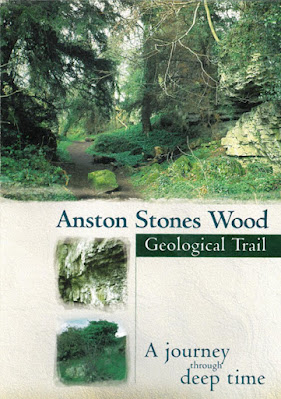 |
| A bryozoan reef at Penny Piece Place |
Just over a week after my visit to Hooton Roberts, where I had a look at the interior of St. John the Baptist’s church and the reddened sandstones on Crooked Lane and Holmes Lane, I returned to Rotherham to lead a field trip to Anston Stones Wood with the Sheffield U3A Geology Group.
Having described several previous visits to this spectacular limestone gorge in this Language of Stone Blog, including the recce for this walk which was described in two parts on 9th and 10th October 2024, there isn’t too much more to add about its geology.
Using the now out of print Anston Stones Wood Geological Trail, which had been produced by the South Yorkshire RIGS (Regionally Important Geological Sites) Group more than 20 years previously, the group had undertaken previous field trips that also entailed a visit to Lindrick Dale to fill the day but, of the 10 other members who turned up on a beautiful sunny day, only 2 had visited this very popular site before.
Setting off from the Anston Parish Council car park, we firstly encountered the Little Stones, which are small outcrops of reef limestone in the Permian Cadeby Formation, before stopping at Dead Man’s Cave, which is perched at the edge of the north side of the gorge.
During the summer, the wood is extremely lush and the canopy of trees along The Cut was particularly thick after a very wet first half of the year and the general consensus of the group was that they couldn't recall a place in England that looked so green. Furthermore, everyone was surprised to see how the trees had colonised the extensive limestone outcrops, with their roots deeply embedded in the joints of the limestone.
Continuing past the old lime kilns, we dropped down to the meandering Anston Brook, where the narrow steep sided gorge expands into a much wider valley. Here, we stopped to have a good look at the excellent information board, which describes the various flora that makes this biological Site of Special Scientific Interest (SSSI) important in South Yorkshire.
At the railway bridge, where the skew arch is built of Staffordshire Blue engineering bricks, we had the advantage of one of our members being a retired civil engineer, who was able to give us a very detailed explanation of this.
Heading back along the gorge on its south side, which was a new experience for all of the group, the only rock exposure that we had an opportunity to examine closely was a section of vertical crags, where undercutting of the thinly bedded limestone at the base has been differentially weathered to leave an overhang.
The main point of interest here is the development of flowstone and a large block of limestone that has become detached from the rock face, but is now connected to the principal rock outcrop by a stalactitic growth of calcite.
As very often happens when leading the group, I didn’t have the opportunities to make a full photographic of the day and, having returned to the car park to have our lunch, we had a wander around North Anston to look at the historic architecture in the North Anston Conservation Area and the remains of the quarry face in Greenlands Park.
Making our way down to Penny Piece Place to look at the magnificent examples of bryozoan reefs, which form part of Clark’s Stones, we were invited by the owners of the house to come into their garden and have a closer look. From here, we retraced our steps back to the centre of the Conservation Area and, after looking at the spring on The Wells, we returned to the car park after another good day out.











No comments:
Post a Comment